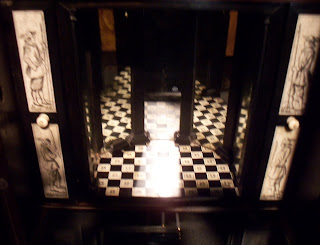Of Cabinets and Calendars
Hope everybody had a good weekend.
Part of mine was spent looking at new exhibitions in old cabinets in the Small Collections Room at Nottingham Contemporary as recommended to me by J at the start of term- thank you J!
Occupying the sort of space one might ascribe to a large wardrobe, this box room is appropriately situated in a study area and contains four cabinets from the seventeenth to the nineteenth centuries containing exhibitions by three contemporary artists.
I wasn't much taken with the lumpen artefacts of Des Hughes, but adored the eighteenth and nineteenth-century micromosaics (once a means of creating stable copies of a painting, but later fashioned into jewellery and trinkets for foreign tourists) as exhibited by Fabrizio Manacorda, which work wonderfully well within their current setting. Enticing the cabinet to give up its secrets with its wobbly, stuck or squeaky drawers and missing handles was all part of the fun, and magnifying glasses were provided so you can really appreciate the craftsmanship of the objects when they emerge into the light.
Trevor Paglen's covert military patches in the final cabinet were another interesting treatment of the cabinet's association with signs, symbols and esoteric knowledge, and his interpretations illuminate some mildly disturbing yet wryly humourous insignia.
Sadly, there was little information on the cabinets themselves, which perhaps would have given a greater insight into the nature of the artists' interaction with them.
I did enjoy opening up the middle section of the second largest cabinet, however- on a superficial note, and because I just bought an advent calendar, it put me in mind of opening the final window as you always know it's going to be something good! Inside was a miniature architectural space- a black-and-white tiled, mirrored enclosure, flanked by black pillars and reflecting both the physical space of the box room and endless spaces leading off into infinity. It was just marvellous, and my first experience of re-opening a cabinet of the old school.


Part of mine was spent looking at new exhibitions in old cabinets in the Small Collections Room at Nottingham Contemporary as recommended to me by J at the start of term- thank you J!
Occupying the sort of space one might ascribe to a large wardrobe, this box room is appropriately situated in a study area and contains four cabinets from the seventeenth to the nineteenth centuries containing exhibitions by three contemporary artists.
I wasn't much taken with the lumpen artefacts of Des Hughes, but adored the eighteenth and nineteenth-century micromosaics (once a means of creating stable copies of a painting, but later fashioned into jewellery and trinkets for foreign tourists) as exhibited by Fabrizio Manacorda, which work wonderfully well within their current setting. Enticing the cabinet to give up its secrets with its wobbly, stuck or squeaky drawers and missing handles was all part of the fun, and magnifying glasses were provided so you can really appreciate the craftsmanship of the objects when they emerge into the light.
Trevor Paglen's covert military patches in the final cabinet were another interesting treatment of the cabinet's association with signs, symbols and esoteric knowledge, and his interpretations illuminate some mildly disturbing yet wryly humourous insignia.
Sadly, there was little information on the cabinets themselves, which perhaps would have given a greater insight into the nature of the artists' interaction with them.
I did enjoy opening up the middle section of the second largest cabinet, however- on a superficial note, and because I just bought an advent calendar, it put me in mind of opening the final window as you always know it's going to be something good! Inside was a miniature architectural space- a black-and-white tiled, mirrored enclosure, flanked by black pillars and reflecting both the physical space of the box room and endless spaces leading off into infinity. It was just marvellous, and my first experience of re-opening a cabinet of the old school.


Comments
Do you think N.C. would tell you more if you contacted them? I understand this isn't the sort of length a normal visitor would go to (but then, would a normal visitor even get the significance?), but it might be interesting anyway.